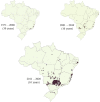Stable fly outbreaks in Brazil: a 50-year (1971-2020) retrospective
- PMID: 37018839
- PMCID: PMC10079268
- DOI: 10.1590/S1984-29612023017
Stable fly outbreaks in Brazil: a 50-year (1971-2020) retrospective
Abstract
Over the last decades, stable fly (Stomoxys calcitrans) outbreaks associated with agricultural and/or livestock production systems have become a serious problem in some Brazilian locations. This article presents a survey on the history, evolution and mapping of such outbreaks in Brazil over five decades (1971-2020). Outbreaks (n= 579) were recorded in 285 municipalities from 14 states, mainly associated with by-products from the ethanol industry (82.7%), in natura organic fertilizers (12.6%) and integrated crop-livestock systems (3.1%). Few cases were reported until the mid-2000s, progressively increasing since then. Outbreaks associated with ethanol mills occurred in 224 municipalities, mainly in Southeast and Midwest states, while those associated with organic fertilizers (mainly poultry litter and coffee mulch) affected 39 municipalities, mostly in the Northeast and Southeast states. More recently, outbreaks in integrated crop-livestock systems during the rainy season have occurred in Midwest states. This survey highlights the magnitude of the problem of stable fly outbreaks in Brazil and its relationship with environmental public policies, agricultural production chains and regional trends. Specific public actions and policies are urgently needed to prevent their occurrence and impact in the affected regions.
Nas últimas décadas, surtos da mosca-dos-estábulos (Stomoxys calcitrans), associados a sistemas de produção agrícola e/ou pecuária, tornaram-se um grave problema em algumas localidades brasileiras. Este artigo apresenta um levantamento sobre a história, evolução e mapeamento desses surtos no Brasil ao longo de cinco décadas (1971-2020). Surtos (n= 579) foram registrados em 285 municípios de 14 estados, principalmente associados a subprodutos da indústria do etanol (82,7%), fertilizantes orgânicos in natura (12,6%) e sistemas de integração lavoura-pecuária (3,1%). Poucos casos foram registrados até meados dos anos 2000, aumentando progressivamente desde então. Surtos associados a usinas de etanol ocorreram em 224 municípios, principalmente no Sudeste e Centro-Oeste, enquanto surtos associados a fertilizantes orgânicos (principalmente esterco aviário e palha de café) afetaram 39 municípios, principalmente nos estados do Nordeste e Sudeste. Mais recentemente, surtos em sistemas de integração lavoura-pecuária, durante a estação chuvosa, têm ocorrido no Centro-Oeste. Este levantamento ressalta a magnitude do problema dos surtos da mosca-dos-estábulos no Brasil e sua relação com políticas públicas ambientais, cadeias produtivas agrícolas e tendências regionais. Ações e políticas públicas específicas são urgentemente necessárias para prevenir sua ocorrência e impacto nas regiões afetadas.
Conflict of interest statement
Figures



References
-
- Alves L. Surtos da mosca do estábulo já chegam à Goiás. Campo. 2012;199:18–19.
-
- Augusto KVZ, Kunz A. In: Manejo ambiental na avicultura. Palhares JC, Kunz A, editors. Concórdia: Embrapa Suínos e Aves; 2011. Tratamento de dejetos de aves poedeiras comerciais. pp. 153–174.
-
- Ávila VS, Mazzuco H, Figueiredo EAP. Cama de aviário: materiais, reutilização, uso como alimento e fertilizante. Concórdia: Embrapa-CNPSA; 1992. [cited 2022 Sep 29]. (Circular Técnica). online. Available from: https://ainfo.cnptia.embrapa.br/digital/bitstream/item/67877/1/CUsersPia... .
-
- AviSite . USDA: volume de carne de frango dos 5 maiores produtores mundiais cresce menos de 1% em 2021. Campinas: AviSite; 2021. [cited 2012 Sep 15]. online. Available from: https://www.avisite.com.br/usda-volume-de-carne-de-frango-dos-5-maiores-...
MeSH terms
LinkOut - more resources
Full Text Sources

